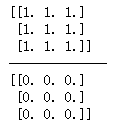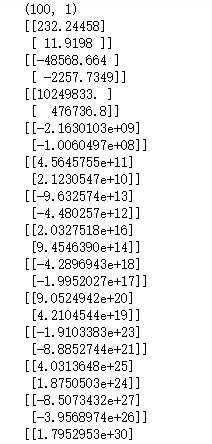吴裕雄 python深度学习与实践(14)
import numpy as np
import tensorflow as tf
import matplotlib.pyplot as plt threshold = 1.0e-2
x1_data = np.random.randn(100).astype(np.float32)
x2_data = np.random.randn(100).astype(np.float32)
y_data = x1_data * 2 + x2_data * 3 + 1.5 weight1 = tf.Variable(1.)
weight2 = tf.Variable(1.)
bias = tf.Variable(1.)
x1_ = tf.placeholder(tf.float32)
x2_ = tf.placeholder(tf.float32)
y_ = tf.placeholder(tf.float32) y_model = tf.add(tf.add(tf.multiply(x1_, weight1), tf.multiply(x2_, weight2)),bias)
loss = tf.reduce_mean(tf.pow((y_model - y_),2)) train_op = tf.train.GradientDescentOptimizer(0.01).minimize(loss) sess = tf.Session()
init = tf.initialize_all_variables()
sess.run(init)
flag = 1
while(flag):
for (x,y) in zip(zip(x1_data, x2_data),y_data):
sess.run(train_op, feed_dict={x1_:x[0],x2_:x[1], y_:y})
if sess.run(loss, feed_dict={x1_:x[0],x2_:x[1], y_:y}) <= threshold:
flag = 0
print("weight1: " ,weight1.eval(sess),"weight2: " ,weight2.eval(sess),"bias: " ,bias.eval(sess))

import tensorflow as tf matrix1 = tf.constant([[3., 3.]])
matrix2 = tf.constant([3., 3.]) sess = tf.Session() print(matrix1)
print(sess.run(matrix1))
print("----------------------")
print(matrix2)
print(sess.run(matrix2))

import tensorflow as tf matrix1 = tf.constant([[3., 3.]])
matrix2 = tf.constant([3., 3.]) sess = tf.Session()
print(sess.run(tf.add(matrix1,matrix2)))

import tensorflow as tf matrix1 = tf.constant([1, 2, 3, 4, 5, 6], shape=[2, 3])
matrix2 = tf.constant([1, 1, 1, 1, 1, 1], shape=[2, 3])
result1 = tf.multiply(matrix1,matrix2) sess = tf.Session()
print(sess.run(result1))

import tensorflow as tf matrix1 = tf.constant([1, 2, 3, 4, 5, 6], shape=[2, 3])
matrix2 = tf.constant([1, 1, 1, 1, 1, 1], shape=[3, 2])
result2 = tf.matmul(matrix1,matrix2) sess = tf.Session()
print(sess.run(result2))

import tensorflow as tf matrix1 = tf.Variable(tf.ones([3,3]))
matrix2 = tf.Variable(tf.zeros([3,3]))
result = tf.matmul(matrix1,matrix2) init=tf.initialize_all_variables()
sess = tf.Session()
sess.run(init) print(sess.run(matrix1))
print("--------------")
print(sess.run(matrix2))

import tensorflow as tf a = tf.constant([[1,2],[3,4]])
matrix2 = tf.placeholder('float32',[2,2])
matrix1 = matrix2
sess = tf.Session()
a = sess.run(a)
print(sess.run(matrix1,feed_dict={matrix2:a}))
import tensorflow as tf
import numpy as np houses = 100
features = 2 #设计的模型为 2 * x1 + 3 * x2
x_data = np.zeros([houses,2])
for house in range(houses):
x_data[house,0] = np.round(np.random.uniform(50., 150.))
x_data[house,1] = np.round(np.random.uniform(3., 7.))
weights = np.array([[2.],[3.]])
y_data = np.dot(x_data,weights) x_data_ = tf.placeholder(tf.float32,[None,2])
y_data_ = tf.placeholder(tf.float32,[None,1])
weights_ = tf.Variable(np.ones([2,1]),dtype=tf.float32)
y_model = tf.matmul(x_data_,weights_) loss = tf.reduce_mean(tf.pow((y_model - y_data_),2))
train_op = tf.train.GradientDescentOptimizer(0.01).minimize(loss) sess = tf.Session()
init = tf.global_variables_initializer()
sess.run(init) for _ in range(10):
for x,y in zip(x_data,y_data):
z1 = x.reshape(1,2)
z2 = y.reshape(1,1)
sess.run(train_op,feed_dict={x_data_:z1,y_data_:z2})
print(weights_.eval(sess))

import tensorflow as tf
import numpy as np houses = 100
features = 2 #设计的模型为 2 * x1 + 3 * x2
x_data = np.zeros([100,2])
for house in range(houses):
x_data[house,0] = np.round(np.random.uniform(50., 150.))
x_data[house,1] = np.round(np.random.uniform(3., 7.))
weights = np.array([[2.],[3.]])
y_data = np.dot(x_data,weights) x_data_ = tf.placeholder(tf.float32,[None,2])
weights_ = tf.Variable(np.ones([2,1]),dtype=tf.float32)
y_model = tf.matmul(x_data_,weights_) loss = tf.reduce_mean(tf.pow((y_model - y_data),2))
train_op = tf.train.GradientDescentOptimizer(0.01).minimize(loss) sess = tf.Session()
init = tf.initialize_all_variables()
sess.run(init) for _ in range(20):
sess.run(train_op,feed_dict={x_data_:x_data})
print(weights_.eval(sess))

import numpy as np a = np.array([[1,2,3],[4,5,6]])
print(a)
b = a.flatten()
print(b)

import numpy as np
import tensorflow as tf filename_queue = tf.train.string_input_producer(["D:\\F\\TensorFlow_deep_learn\\data\\cancer.txt"], shuffle=False)
reader = tf.TextLineReader()
key, value = reader.read(filename_queue)
record_defaults = [[1.0], [1.0], [1.0], [1.0], [1.0], [1.0], [1.0]]
col1, col2, col3, col4, col5 , col6 , col7 = tf.decode_csv(value,record_defaults=record_defaults)
print(col1)

import numpy as np
import tensorflow as tf def readFile(filename):
filename_queue = tf.train.string_input_producer(filename, shuffle=False)
reader = tf.TextLineReader()
key, value = reader.read(filename_queue)
record_defaults = [[1.0], [1.0], [1.0], [1.0], [1.0], [1.0], [1.0]]
col1, col2, col3, col4, col5 , col6 , col7 = tf.decode_csv(value,record_defaults=record_defaults)
label = tf.stack([col1,col2])
features = tf.stack([col3, col4, col5, col6, col7])
example_batch, label_batch = tf.train.shuffle_batch([features,label],batch_size=3, capacity=100, min_after_dequeue=10)
return example_batch,label_batch example_batch,label_batch = readFile(["D:\\F\\TensorFlow_deep_learn\\data\\cancer.txt"]) weight = tf.Variable(np.random.rand(5,1).astype(np.float32))
bias = tf.Variable(np.random.rand(3,1).astype(np.float32))
x_ = tf.placeholder(tf.float32, [None, 5])
y_model = tf.matmul(x_, weight) + bias
y = tf.placeholder(tf.float32, [None, 1]) loss = -tf.reduce_sum(y*tf.log(y_model))
train = tf.train.GradientDescentOptimizer(0.1).minimize(loss)
init = tf.initialize_all_variables() with tf.Session() as sess:
sess.run(init)
coord = tf.train.Coordinator()
threads = tf.train.start_queue_runners(coord=coord)
flag = 1
while(flag):
e_val, l_val = sess.run([example_batch, label_batch])
sess.run(train, feed_dict={x_: e_val, y: l_val})
if sess.run(loss,{x_: e_val, y: l_val}) <= 1:
flag = 0
print(sess.run(weight))
吴裕雄 python深度学习与实践(14)的更多相关文章
- 吴裕雄 python深度学习与实践(15)
import tensorflow as tf import tensorflow.examples.tutorials.mnist.input_data as input_data mnist = ...
- 吴裕雄 python深度学习与实践(18)
# coding: utf-8 import time import numpy as np import tensorflow as tf import _pickle as pickle impo ...
- 吴裕雄 python深度学习与实践(17)
import tensorflow as tf from tensorflow.examples.tutorials.mnist import input_data import time # 声明输 ...
- 吴裕雄 python深度学习与实践(16)
import struct import numpy as np import matplotlib.pyplot as plt dateMat = np.ones((7,7)) kernel = n ...
- 吴裕雄 python深度学习与实践(13)
import numpy as np import matplotlib.pyplot as plt x_data = np.random.randn(10) print(x_data) y_data ...
- 吴裕雄 python深度学习与实践(12)
import tensorflow as tf q = tf.FIFOQueue(,"float32") counter = tf.Variable(0.0) add_op = t ...
- 吴裕雄 python深度学习与实践(11)
import numpy as np from matplotlib import pyplot as plt A = np.array([[5],[4]]) C = np.array([[4],[6 ...
- 吴裕雄 python深度学习与实践(10)
import tensorflow as tf input1 = tf.constant(1) print(input1) input2 = tf.Variable(2,tf.int32) print ...
- 吴裕雄 python深度学习与实践(9)
import numpy as np import tensorflow as tf inputX = np.random.rand(100) inputY = np.multiply(3,input ...
随机推荐
- 第七十九课 最短路径(Floyd)
程序如下: #ifndef GRAPH_H #define GRAPH_H #include "Object.h" #include "SharedPointer.h&q ...
- LCA - Tarjan 算法
void dfs(int u) { ; i <= n; i++) { if(visit[i]&&ask[u][i]) { LCA[u][i] = Find(i); } } vis ...
- 日常遇错之ModuleNotFoundError: No module named request
用pycharm写python的时候,import request时,报错:ModuleNotFoundError: No module named request emmmm.解决方法:pip in ...
- 2018.4.24 快排查找第K大
import java.util.Arrays; /* 核心思想:利用快排思想,先假定从大到小排序,找枢纽,枢纽会把大小分开它的两边,当枢纽下标等于k时, 即分了k位在它左边或右边,也就是最大或最小的 ...
- linux sar命令详解
sar(System Activity Reporter系统活动情况报告)是目前 Linux 上最为全面的系统性能分析工具之一,可以从多方面对系统的活动进行报告,包括:文件的读写情况.系统调用的使用情 ...
- PHP处理上传文件信息数组中的文件类型 正确获取
PHP处理上传文件信息数组中的文件类型$_FILES['type']由客户端浏览器提供,有可能是黑客伪造的信息,请写一个函数来确保用户上传的图像文件类型真实可靠 如果是一般文件则通过 mime_con ...
- win 10 kms 激活 后 火狐 上 https 网站 报错
原因: 系统导入了未知的根证书 影响:?? 解决方法: http://mozilla.com.cn/thread-374897-1-1.html
- 浅谈JavaScript函数重载
上个星期四下午,接到了网易的视频面试(前端实习生第二轮技术面试).面了一个多小时,自我感觉面试得很糟糕的,因为问到的很多问题都很难,根本回答不上来.不过那天晚上,还是很惊喜的接到了HR面电话.现在HR ...
- python学习路程1
常用的转义字符还有: \n 表示换行 \t 表示一个制表符 \\ 表示 \ 字符本身 任务 请将下面两行内容用Python的字符串表示并打印出来: Python was started in 1989 ...
- JDK / JRE zip
Server JRE与JRE的区别: Server JRE一般用于服务器上安装,只有64bit版本,不会安装浏览器插件.自动更新,有监视工具.没有Java Fx和其他开发工具:有安装程序,只是一压缩目 ...
